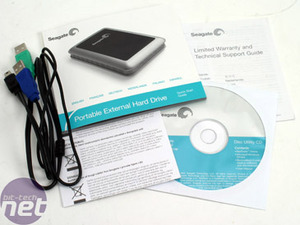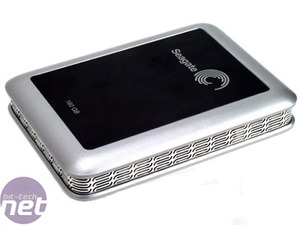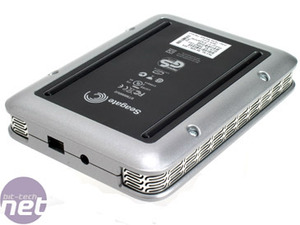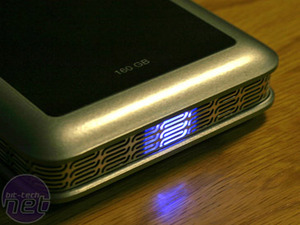Portable storage is something key to many people’s lives. Lots of us carry USB sticks on our key rings just in case we need to pop an important document / music / video on it while we’re out, but for some that few GB of mini storage just isn’t enough.
Carrying around a 500GB Behemoth with its own power adapter, like the Seagate 500GB eSATA drive that Tim reviewed last month isn’t exactly practical, but you can opt for something in between: a 2.5” portable disk. In the past 2.5" hard drives have had pretty poor sizes and have been dwarfed by their bigger 3.5” brothers but Seagate has just released a 160GB external drive that adds masses of storage in a cool pocket-sized case (it's more coat pocket-sized though - Ed.).
For those of us with laptops, an extra storage option can be invaluable for two reasons; the first is that you don’t have to open your laptop to replace the internal drive with a larger one, which means possibly voiding the warranty and having to reinstall your OS. Secondly, an external drive can be given to anyone, making large file transfers easier and safer to transport, however it does provide a constant, extra battery drain.



 The USB cable has three plugs: one end has the mini-USB for plugging into the device, and the other end contains two full size USB connectors, one for power only and the other for power and data. Since the enclosure is powered solely from the USB port and because it pulls an amp of current on spin-up, sometime you will get the following pop-up warning from Windows and the drive fails to initialise.
The USB cable has three plugs: one end has the mini-USB for plugging into the device, and the other end contains two full size USB connectors, one for power only and the other for power and data. Since the enclosure is powered solely from the USB port and because it pulls an amp of current on spin-up, sometime you will get the following pop-up warning from Windows and the drive fails to initialise.
 To counter this, plugging in both USB ports will distribute the power to the unit over them both. This does take up an extra USB port, which might be a problem on laptops where they are limited in supply. Seagate does provide a plug socket on the product if you wish to power it separately, but you’ll have to provide the power adapter yourself, although there’s no indication on the device as to the specifications it requires.
To counter this, plugging in both USB ports will distribute the power to the unit over them both. This does take up an extra USB port, which might be a problem on laptops where they are limited in supply. Seagate does provide a plug socket on the product if you wish to power it separately, but you’ll have to provide the power adapter yourself, although there’s no indication on the device as to the specifications it requires.
Seagate houses its 2.5" 160GB portable drive in a custom metal enclosure with swirly pattern in the thin metal sides to aid ventilation. The unit is fairly hefty but very solidly built. The extra mass keeps the drive very cool, even after extended operation. Compared to my £5 external box from Ebuyer, it’s significantly wider and fatter, although this should make it more drop tolerant; Seagate states that the drive can take 5000Gs of non-operating shock. The enclosure is far more hard-wearing than my own portable enclosure though, as it comes with a chrome plated aluminium design that makes it more resistant to the inevitable scratches.
On the bottom there are a pair of anti-slip rubber feet running the length of the case, and a blue LED at the front that indicates drive power and activity. The blue LED is a bit cliché now, and the red / green LED on my £5 el cheapo drive has independent power and activity indicators. It sort of spoils the clean lines and we think it would have been better to not only include a dual colour LED at a little extra cost, but also for the LED light to be diffused all the way along the front of the unit instead of having it in a central block.

 The drive itself is a 160GB model (145GB usable space), with 8MB cache, ATA interface and a 5,400 RPM FDB (fluid bearing) motor for quiet, but reasonably fast operation. Sure, it’s no super fast 7,200 RPM version, but the limiting factor is USB bandwidth and you’ll get less battery drain with a 5,400 RPM drive.
The drive itself is a 160GB model (145GB usable space), with 8MB cache, ATA interface and a 5,400 RPM FDB (fluid bearing) motor for quiet, but reasonably fast operation. Sure, it’s no super fast 7,200 RPM version, but the limiting factor is USB bandwidth and you’ll get less battery drain with a 5,400 RPM drive.
The drive comes pre-formatted with FAT32, although for Windows machines you may want to reformat it with NTFS. If you’re using it for transferring data between a Mac and Windows OS, you will need to leave it FAT32, however Seagate specifically states in the manual this is a non-ideal solution considering how Mac OS’ work and could result in data loss. It suggested formatting the drive on the Mac, for use with the Mac primarily, and then using extra software (not provided) to access the Mac formatted data from a Windows PC.
Carrying around a 500GB Behemoth with its own power adapter, like the Seagate 500GB eSATA drive that Tim reviewed last month isn’t exactly practical, but you can opt for something in between: a 2.5” portable disk. In the past 2.5" hard drives have had pretty poor sizes and have been dwarfed by their bigger 3.5” brothers but Seagate has just released a 160GB external drive that adds masses of storage in a cool pocket-sized case (it's more coat pocket-sized though - Ed.).
For those of us with laptops, an extra storage option can be invaluable for two reasons; the first is that you don’t have to open your laptop to replace the internal drive with a larger one, which means possibly voiding the warranty and having to reinstall your OS. Secondly, an external drive can be given to anyone, making large file transfers easier and safer to transport, however it does provide a constant, extra battery drain.


The Hardware
In the box you get, the drive itself, a USB cable, the usual instruction manuals, and software for windows drivers and backup.


Seagate houses its 2.5" 160GB portable drive in a custom metal enclosure with swirly pattern in the thin metal sides to aid ventilation. The unit is fairly hefty but very solidly built. The extra mass keeps the drive very cool, even after extended operation. Compared to my £5 external box from Ebuyer, it’s significantly wider and fatter, although this should make it more drop tolerant; Seagate states that the drive can take 5000Gs of non-operating shock. The enclosure is far more hard-wearing than my own portable enclosure though, as it comes with a chrome plated aluminium design that makes it more resistant to the inevitable scratches.
On the bottom there are a pair of anti-slip rubber feet running the length of the case, and a blue LED at the front that indicates drive power and activity. The blue LED is a bit cliché now, and the red / green LED on my £5 el cheapo drive has independent power and activity indicators. It sort of spoils the clean lines and we think it would have been better to not only include a dual colour LED at a little extra cost, but also for the LED light to be diffused all the way along the front of the unit instead of having it in a central block.


The drive comes pre-formatted with FAT32, although for Windows machines you may want to reformat it with NTFS. If you’re using it for transferring data between a Mac and Windows OS, you will need to leave it FAT32, however Seagate specifically states in the manual this is a non-ideal solution considering how Mac OS’ work and could result in data loss. It suggested formatting the drive on the Mac, for use with the Mac primarily, and then using extra software (not provided) to access the Mac formatted data from a Windows PC.

MSI MPG Velox 100R Chassis Review
October 14 2021 | 15:04









Want to comment? Please log in.